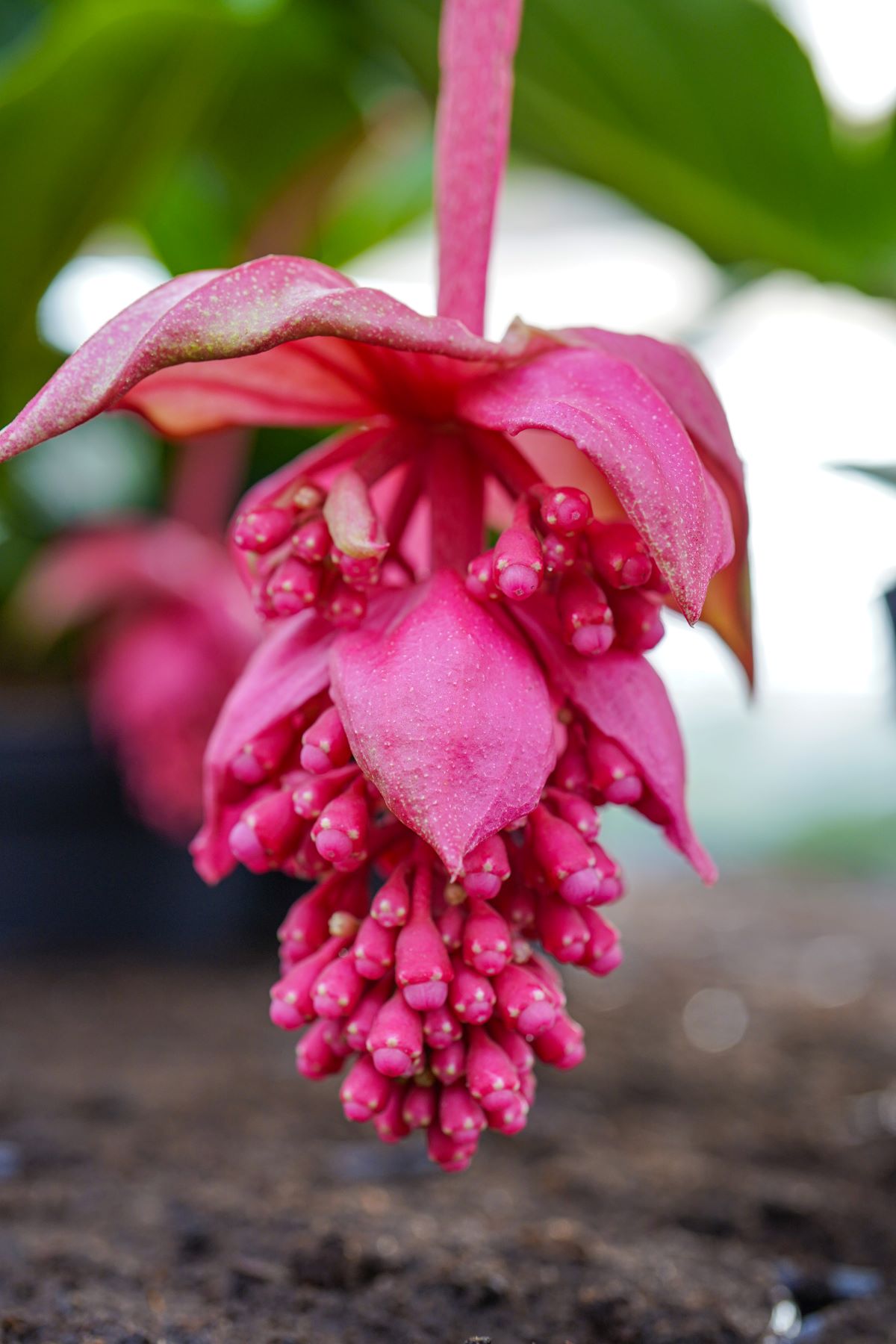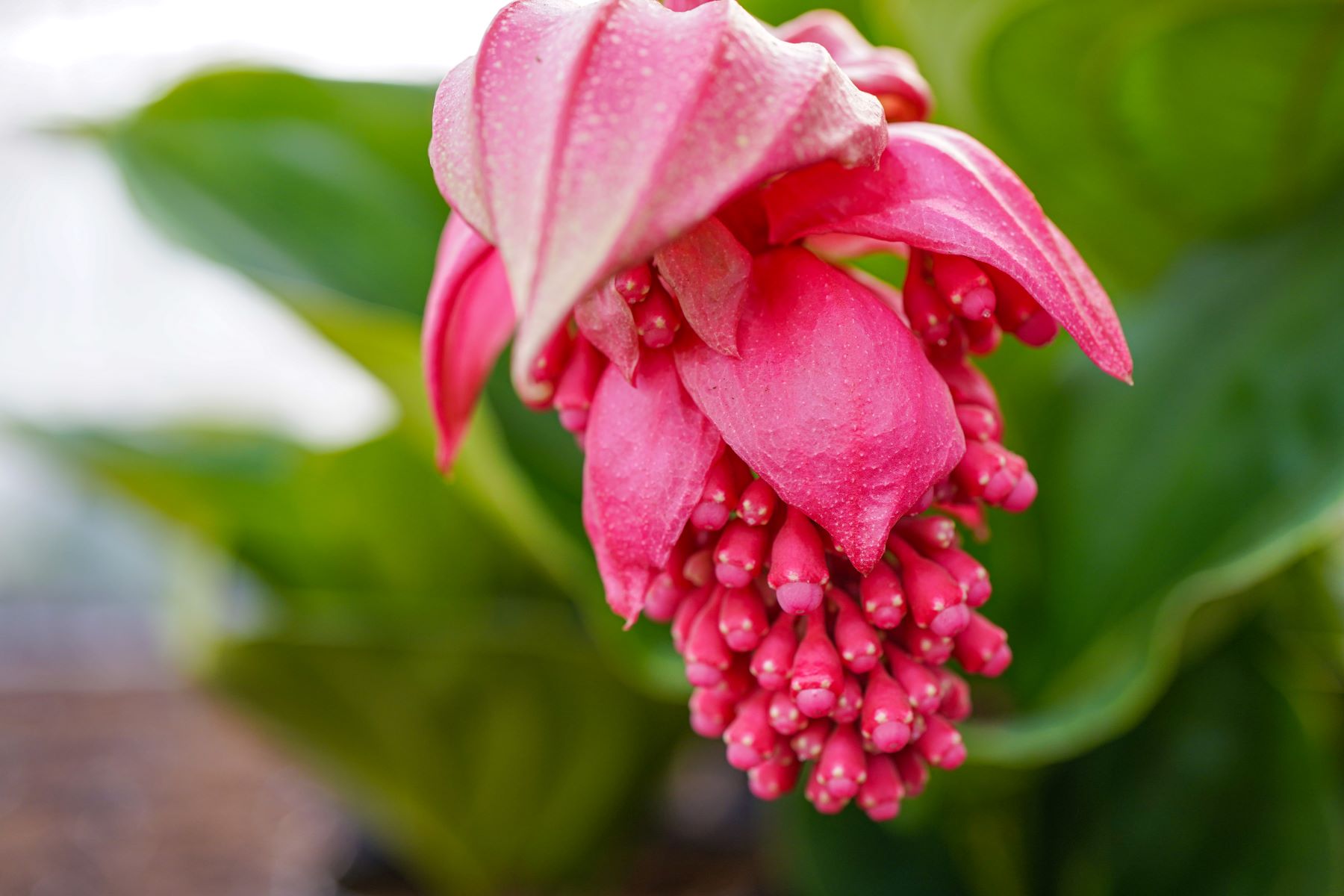Medinilla
The Medinilla is a striking houseplant belonging to the Melastomataceae family and originates from Southeast Asia and tropical Africa. The Medinilla Magnifica originally comes from the Philippines. It owes its name to its discoverer, governor J. de Medinilla of the Mariana Islands. The Medinilla is what is known as an epiphyte, which means that in nature it grows on other plants or trees without extracting nutrients from them.
With its graceful, hanging pink flower clusters and cork-like stems, this plant gives any interior an exotic look. In nature, this plant can grow up to 3 meters tall. But according to our grower Laguna, you don’t need to worry about that indoors. In a living room environment, the plant grows up to about 1 meter tall, depending on care, light, and humidity.
Did you know…
In the Philippines, the plant is also known under the name Kapa-Kapa? It was given this name because the long, hanging flowers remind Filipinos of the traditional fabrics called “Kapa.”
Medinilla Magnifica care
The Medinilla is not the most difficult plant to care for. When you give it the right attention, you will enjoy this tropical beauty for a long time. Want to know how to best care for the Medinilla? In short, here are our care tips:
- If the leaves droop or the soil has dried out, give it water.
- Place it in a bright spot, but avoid direct sunlight.
- Do not feed during its flowering period or in autumn and winter.
- Repot the Medinilla every 2/3 years in spring.
Medinilla care tips
How often and when should you water a Medinilla?
Give the Medinilla Magnifica a small amount of water once a week so that it always stands in lightly moist soil. Make sure no layer of water remains in the pot, as this can lead to root rot. It is better to give it too little water than too much.
The advantage is that the Medinilla shows when it needs water. Do you see the leaves and flower stems drooping? Then water it immediately and you will see it perk up quickly. An ideal plant for people without green fingers 😊
Misting
Due to its tropical roots, the Medinilla thrives in high humidity. Mist it regularly. This increases humidity, improves the plant’s health, and removes dust from the leaves.
Best location for your Medinilla
The Medinilla prefers a bright spot in the house but cannot tolerate direct sunlight. An east- or west-facing window is ideal. If you only have a south-facing window, place it at least two to three meters away. This prevents leaf burn.
Avoid draughts and temperatures below 10 °C. During flowering, it prefers warmth (above 18 °C). After flowering, it prefers slightly cooler temperatures (16–18 °C) to stimulate the formation of new buds.
Increased humidity in the room is also beneficial for the Medinilla. As mentioned before, regular misting is fine.
Can a Medinilla Magnifica be placed outdoors?
Yes, in summer you can put the Medinilla outdoors. Just not in full sun. It also doesn’t like big temperature swings, so let it acclimatize when you move it outside, and bring it indoors once it gets colder than 10 °C.
Should you repot a Medinilla?
It is advisable to repot the Medinilla every two to three years. Do this preferably in spring, when the plant comes out of its resting phase. Never repot during flowering, as this can cause bud loss or stress.
Choose a pot about 20% larger than the previous one and ensure good drainage by using a pot with holes in the bottom. Fill the new pot with airy potting soil or coco soil and avoid heavy soils. After repotting, water sparingly so that the roots can adapt to their new environment.
Repotting not only stimulates growth but also gives you the chance to check the roots for possible rot or pests.
After flowering, so not during flowering, you may feed the Medinilla every two weeks. Preferably use liquid fertilizer for flowering houseplants or orchids. Always dilute the fertilizer according to the package instructions and never use more than recommended.
Stop fertilizing from the end of August and do not feed during autumn and winter. In this resting phase, the plant needs less energy. Overfeeding can cause discoloration of the leaves and flower buds.
Is the Medinilla a toxic plant?
No, the Medinilla is not toxic to humans or pets. A safe choice for your home.
Still, it is wise to keep plants out of reach to prevent damage. Otherwise, your pets might see the plant as a toy 😊
Prune spent flowers of the flower cluster after blooming at the base. If the plant becomes too large, you can also remove a stem at the base. Pruning is best done in spring, right after flowering.
How should I prune my Medinilla?
Use sharp pruning shears and cut only what is necessary. Don’t overdo it, as excessive pruning does not stimulate extra flowering and may harm the plant’s shape.
How long does a Medinilla bloom?
The Medinilla flowers from November to February. The elegant flower clusters can remain beautiful for up to five months, making this plant extra special.
How do you get a Medinilla to bloom again?
After flowering, remove the spent flower stems. Then place the Medinilla Magnifica in a cooler spot (16–18 °C) with plenty of light to stimulate new flowering. Continue watering regularly and add some fertilizer every two weeks.
Once the new shoots are large enough, return the plant to a warmer spot.
Although the Medinilla is a stunning appearance, it is not known for its air-purifying effect.
Diseases and pests in the Medinilla Magnifica
A common phenomenon in the Medinilla is a white, powdery coating on the leaves. These are growth sugars produced during flowering and are harmless.
In addition, the plant can be affected by mealybugs or scale insects. You can combat these by spraying them off with a strong stream of water or, if necessary, with a suitable chemical product. Repeat the treatment for effective control.
There are different types of insects that can affect (indoor) plants.
Appearance characteristics of the Medinilla
Is your Medinilla Magnifica not performing as expected? That can happen! Every plant has its own unique needs, so care is not always straightforward. Below we list the most frequently asked questions:
Does your Medinilla have white powder on its leaves?
If you see white powder on the leaves of your Medinilla, don’t worry. These small white balls are growth sugars that appear during flowering and are harmless.
Why does my Medinilla Magnifica get brown leaves?
This is often due to overwatering or a spot that is too dark. Move the plant and adjust watering.
Why are the leaves of my Medinilla falling off?
The most common causes are too much water, too little light, draughts, or too much fertilizer. Place it in a stable, light spot and adjust watering. That should restore your Medinilla.
Lifespan of the Medinilla Magnifica
The Medinilla is a perennial plant! So take good care of it and enjoy it for many years.



